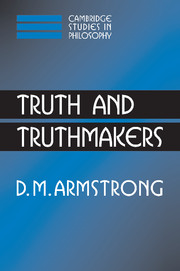Book contents
- Frontmatter
- Contents
- Preface
- 1 An introduction to truthmakers
- 2 The general theory of truthmaking
- 3 Epistemology and methodology
- 4 Properties, relations and states of affairs
- 5 Negative truths
- 6 General truths
- 7 Truthmakers for modal truths, part 1: possibility
- 8 Truthmakers for modal truths, part 2: necessity
- 9 Numbers and classes
- 10 Causes, laws and dispositions
- 11 Time
- References
- Index
1 - An introduction to truthmakers
Published online by Cambridge University Press: 22 September 2009
- Frontmatter
- Contents
- Preface
- 1 An introduction to truthmakers
- 2 The general theory of truthmaking
- 3 Epistemology and methodology
- 4 Properties, relations and states of affairs
- 5 Negative truths
- 6 General truths
- 7 Truthmakers for modal truths, part 1: possibility
- 8 Truthmakers for modal truths, part 2: necessity
- 9 Numbers and classes
- 10 Causes, laws and dispositions
- 11 Time
- References
- Index
Summary
I first learnt to appreciate the power of the notion of a truthmaker from C. B. (Charlie) Martin. A survey of the arguments I was introduced to then should serve as a good introduction to this essay.
The time was the late 1950s, and Martin was a lecturer at the University of Adelaide. I was at Melbourne University. At the time we were both interested in the doctrine of phenomenalism, the claim that physical objects are constituted out of sense-data or sense-impressions. Neither of us had any sympathy for this view, but it was in the air at the time. The question for us was how it was best argued against.
Phenomenalists had a problem about physical objects and events at times that they are not being perceived. The solution to the problem generally given is to be found in embryo in Berkeley and became firm doctrine in John Stuart Mill. It involved an appeal to certain counterfactual truths. Counterfactual claims are often to be found in ordinary discourse, for instance, ‘If you had not put your foot on the brake so promptly just then, there would have been a nasty accident.’ There can be rational discussion of such claims, and it is plausible that they can be true as well as false, though some philosophers want to say that they are no more than ‘assertible’ or ‘not assertible’.
- Type
- Chapter
- Information
- Truth and Truthmakers , pp. 1 - 3Publisher: Cambridge University PressPrint publication year: 2004



